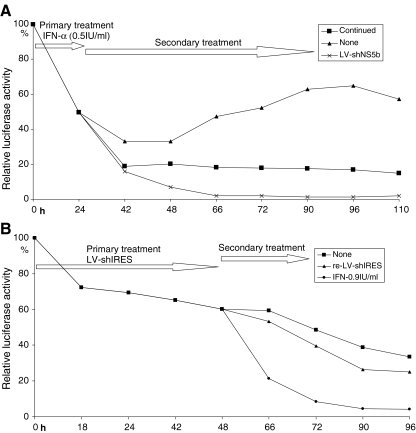Fig. 6.
Subsequential treatment of IFN-α and RNAi reciprocally enhances inhibition of HCV replication. a Huh7-ET cells were treated with low dose (0.5 IU/ml) of IFN-α 24 h after which medium was replaced, and cells were treated a second time for an additional 86 h. Secondary treatment with IFN-α resulted in a maximum inhibition of 81.3% ± 1.3 (n = 7, P < 0.001) from t = 42 h onward. However, subsequently switching IFN-α to LV-shNS5b resulted in a significantly greater inhibition of viral replication (98.2% ± 0.2 inhibition, n = 6, P < 0.001). In Huh7-ET cells without secondary treatment, HCV replication was partially restored to approx. two third of baseline levels at 2 days after switching. b Conversely, Huh7-ET cells primarily treated with LV-shIRES were more sensitive to a secondary treatment with IFN-α than re-treatment with the same LV-shIRES vector. Secondary treatment with 0.9 IU/ml IFN-α resulted in profound inhibition of viral replication (96% ± 0.6 inhibition at t = 96 h, n = 6, P < 0.001) as compared to secondary treatment with vector (75.1% ± 3.7 inhibition, n = 6). In Huh7-ET, cells without additional treatment HCV replication was (66.4% ± 5.4 inhibition, n = 6). Overall, these findings indicate that cells treated with IFN-α are more sensitive to subsequential treatment with RNAi than re-treatment with IFN-α. Equally, cells treated with RNAi are more sensitive to subsequential treatment with IFN-α than re-treatment with RNAi

